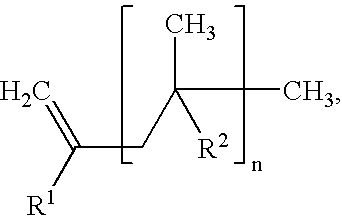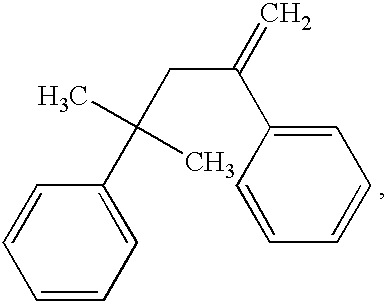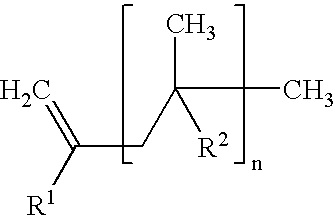Cross-linkable polymer composition
a polymer composition and cross-linking technology, applied in the field of cross-linkable polymers, can solve the problems of poor water resistance of the final coating composition, large amount of protective colloids and surfactants, and high cost, and achieve good film formation, good chemical resistance, and fast hardness development
- Summary
- Abstract
- Description
- Claims
- Application Information
AI Technical Summary
Benefits of technology
Problems solved by technology
Method used
Image
Examples
example 1
A polymer dispersion was prepared using the composition of Table I. The preparation is described,in Table II.
TABLE IScheme for emulsion polymerization (amounts in g).mixturecompoundgADemineralized water104.2BMethacrylic Acid5.64Butyl methacrylate5.2α-Methylstyrene dimer0.832-Hydroxyethylmethacrylate4.44CButylmethacrylate43.4α-Methylstyrene dimer3.32-Hydroxyethylmethacrylate17.76DAmmonia 25%4.6ETrigonox ® A-W 704.6Demineralized water25FSodium formaldehyde sulfoxylate1.61Demineralized water25Trigonox ® A-W 70 is a trademark of Akzo Nobel (t-butylhydroperoxide, 70% in water)
TABLE IIScheme for the preparation:Procedure for the preparation:1. Homogenize each of the mixtures of [B], [C], [E], [F]2. Load in the reactor (round bottom flask) mixture [A]3. Heat the contents of the reactor to 65° C. under a nitrogen blanket.4. Subsequently add the mixtures according the following scheme,keeping the temperature at 65° C.:a.[B] started at t = 0 dosed till 18 min.b.[D] started at t = 0 dosed til...
example 2
A polymer dispersion was prepared using the composition of Table III. The preparation is described in Table IV.
TABLE IIIScheme for the emulsion polymerization (amounts in g).MixtureCompoundgramsADemineralized water157BMethacrylic Acid1.53Butyl methacrylate11.89α-Methylstyrene dimer1.042-Hydroxyethyl methacrylate5.57CMethacrylic Acid1.3Butyl methacrylate10.972-Hydroxyethyl methacrylate4.73DButyl methacrylate57.72-Hydroxyethyl methacrylate22.26EAmmonium persulfate0.25Demineralized water15FDemineralized water3GPerkadox AMBN ®1.61Demineralized water251-methoxy-2-propanol16.2Perkadox AMBN ® (2,2′-azobis(2-methylbutyronitrile)) is a trademark of Akzo Nobel
TABLE IVScheme for the preparation: Procedure for the preparation:1.Homogenize each of the mixtures of [B], [C], [E], [F]2.Load [A] into the reactor (round bottom flask)3.Apply 3 vacuum / nitrogen flushes at RT4.Heat the contents of the stirred reactor to 90° C. under a nitrogenblanket.5.Subsequently add the mixtures according the...
example 3
A polymer dispersion was prepared using the composition of Table VII.
TABLE VIIADemineralized water770Bα-methyl styrene dimer2.1Methacrylic acid37.9CAmmonia (25% aqueous29.9solution)Demineralized water101DSodium persulfate1.00Demineralized water100EMethyl methacrylate623.52-ethyl hexyl acrylate240.5Styrene48.0Acetoacetoxyethylmethacrylate48.0FDemineralized water200Sodium persulfate7.0GAmmonia (25% aqueous5.0solution)HDemineralized water10Trigonox AW-701.06IDemineralized water10Sodium formaldehyde0.80sulfoxylateJAmmonia (25% aqueous5solution)
The following procedure was used. A two liter double jacketed glass reactor equipped with a two-blade stirrer, a condenser, and inlets for addition of monomer pre-emulsions, initiator, and other auxiliaries, was charged with portion A and heated under a nitrogen stream to 90° C. When the temperature of the batch reached 90° C., portions B, C and D were dosed into the reactor simultaneously over a period of 60 minutes. Subsequently the addition of ...
PUM
| Property | Measurement | Unit |
|---|---|---|
| water-soluble | aaaaa | aaaaa |
| water-insoluble | aaaaa | aaaaa |
| acid | aaaaa | aaaaa |
Abstract
Description
Claims
Application Information
 Login to View More
Login to View More - R&D
- Intellectual Property
- Life Sciences
- Materials
- Tech Scout
- Unparalleled Data Quality
- Higher Quality Content
- 60% Fewer Hallucinations
Browse by: Latest US Patents, China's latest patents, Technical Efficacy Thesaurus, Application Domain, Technology Topic, Popular Technical Reports.
© 2025 PatSnap. All rights reserved.Legal|Privacy policy|Modern Slavery Act Transparency Statement|Sitemap|About US| Contact US: help@patsnap.com



